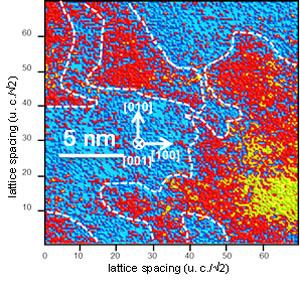
The domains form because some atoms undergo a displacement in the x direction and others in the y direction. Domains are only a few nanometers in size, and x-ray and neutron- experiments have to date averaged data between the two domain types, incorrectly identifying a uniform structure. The size of the domains is found to correlate with the local magnetic moment of the Fe atoms and superconductivity. When superconductivity is optimal, the Fe magnetic fluctuations are strong and the domains are large (up to 15 nm in size). When superconductivity and magnetic fluctuations are weak, the domains get smaller.
Our study demonstrates that aberration-corrected scanning transmission electron microscopy (STEM) can reveal atomic-size structural irregularities that would otherwise be missed when less spatially resolved techniques average data.
Claudia Cantoni, Michael A. McGuire, Bayrammurad Saparov, Andrew F. May, Trevor Keiber, Frank Bridges, Athena S. Sefat, and Brian C. Sales, “Room-Temperature Ba(Fe1− x Cox )2 As2 Is Not Tetragonal: Direct Observation of Magnetoelastic Interactions in Pnictide Superconductors,” Adv. Mater. DOI: 10.1002/adma.201404079
For more information

